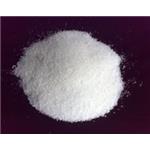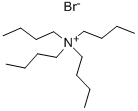Tetrabutylammonium Bromide: A Versatile Phase-Transfer Catalyst for Efficient Synthesis of Bioactive N-Heterocycles
General Description
Tetrabutylammonium bromide, a versatile phase-transfer catalyst, plays a crucial role in various chemical reactions owing to its excellent solubility in aqueous and organic solvents. Known for its environmental friendliness, stability, and cost-effectiveness, it is widely used in industrial applications. In the synthesis of bioactive N-heterocycles, including 1,4-dihydropyridines and 2-substituted imidazolines, Tetrabutylammonium bromide significantly enhances reaction efficiency and yields. Its involvement in environmentally benign synthesis processes, such as 2,4,5-triaryl imidazoles under reflux conditions, showcases its broad utility. Overall, Tetrabutylammonium bromide's effectiveness as a catalyst in diverse reactions highlights its importance in modern synthetic chemistry for producing biologically active compounds efficiently.
Figure 1. Tetrabutylammonium bromide
Overview
Tetrabutylammonium bromide is a highly regarded phase-transfer catalyst that has demonstrated significant utility in various chemical reactions. This compound is an ammonium salt known for its excellent solubility in both aqueous and organic solvents, which is crucial for its role in transporting anionic reactants across different phases. Tetrabutylammonium bromide's properties include being environmentally friendly, non-volatile, non-flammable, non-corrosive, and cost-effective, which makes it a preferred choice in industrial applications. Additionally, tetrabutylammonium bromide boasts high thermal and chemical stability, further enhancing its appeal for use under rigorous conditions. Tetrabutylammonium bromide has also been used as an ionic liquid in solvent-free organic transformations, highlighting its versatility and efficiency. Its effectiveness as a co-catalyst has been proven to enhance reaction rates and product yields in various synthetic processes. The unique capabilities of tetrabutylammonium bromide make it an indispensable tool in modern synthetic chemistry, where it continues to be explored for new applications and reaction efficiencies. 1
Applications for the Synthesis of Bioactive N-Heterocycles
Synthesis of 1,4-Dihydropyridines
Tetrabutylammonium bromide has proven itself as an indispensable phase-transfer catalyst in the field of synthetic chemistry, particularly in the creation of bioactive N-heterocycles. These compounds are significant due to their extensive range of biological and pharmacological activities. The role of Tetrabutylammonium bromide in these syntheses is not only pivotal but also enhances the efficiency and yields of the reactions. One of the key applications of Tetrabutylammonium bromide is in the synthesis of 1,4-dihydropyridines, which are recognized for their broad spectrum of biological properties, including antibacterial, antidiabetic, and anticancer activities. A notable method introduced by Kumar et al. in 2014 utilizes Tetrabutylammonium bromide as a catalyst in a pseudo four-component Hantzsch reaction. This method effectively produces 1,4-dihydropyridine derivatives from aryl and heteroaryl aldehydes in aqueous medium at 60°C, achieving excellent product yields.
Synthesis of 2-Substituted Imidazolines
Further expanding the scope of Tetrabutylammonium bromide's utility, Liu et al. employed it in the synthesis of 2-substituted imidazolines. This reaction involves the condensation of aromatic aldehydes with ethylenediamine, facilitated by a catalytic system comprising Tetrabutylammonium bromide and tungstophosphoric acid. Conducted in water at 80°C, the presence of Tetrabutylammonium bromide is crucial for obtaining higher yields of the desired imidazolines, showcasing its effectiveness in enhancing reaction conditions.
Microwave-Assisted Synthesis of 2,4,5-Triaryl Imidazoles
Additionally, Tetrabutylammonium bromide has been used in the environmentally benign synthesis of 2,4,5-triaryl imidazoles. Chary et al. developed a protocol that utilizes Tetrabutylammonium bromide under reflux conditions. This method allows for the smooth progression of reactions involving various aryl aldehydes and benzyl substrates, producing high yields of triaryl imidazoles efficiently within a short period. The versatility of Tetrabutylammonium bromide extends to its use in microwave-assisted synthesis processes. These processes benefit from the rapid heating and efficient energy use provided by microwaves, with Tetrabutylammonium bromide acting as a key catalyst that significantly boosts reaction rates and yields.
In summary, Tetrabutylammonium bromide's role as a phase-transfer catalyst is critical across a variety of chemical syntheses, particularly in the formation of bioactive N-heterocycles. Its ability to improve reaction conditions, increase yields, and shorten reaction times, while being used in environmentally friendly protocols, underscores its importance in modern synthetic chemistry. This compound not only facilitates complex chemical transformations but also contributes to the advancement of medicinal chemistry through the development of biologically active molecules. 2
Reference
1. Tetrabutylammonium bromide. National Center for Biotechnology Information. 2024; PubChem Compound Summary for CID 74236.
2. Banik BK, Banerjee B, Kaur G, Saroch S, Kumar R. Tetrabutylammonium Bromide (TBAB) Catalyzed Synthesis of Bioactive Heterocycles. Molecules. 2020; 25(24): 5918.
);Related articles And Qustion
Lastest Price from Tetrabutylammonium bromide manufacturers

US $1.00/g2024-09-19
- CAS:
- 1643-19-2
- Min. Order:
- 1g
- Purity:
- 99%
- Supply Ability:
- 100kg

US $100.00-70.00/kg2024-09-19
- CAS:
- 1643-19-2
- Min. Order:
- 1kg
- Purity:
- 99%
- Supply Ability:
- 5000




